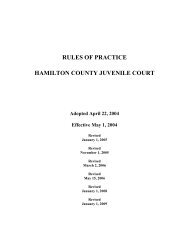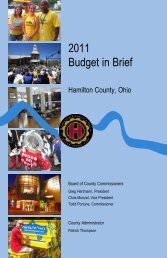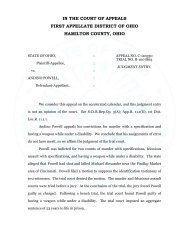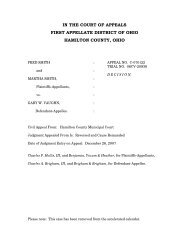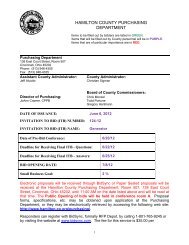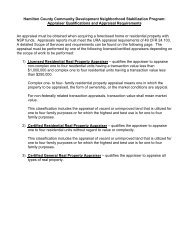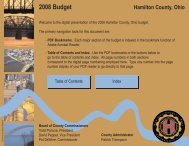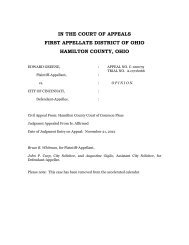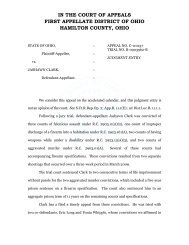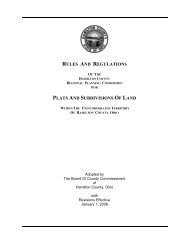Planning Commissioners' Procedures Manual - Hamilton County, Ohio
Planning Commissioners' Procedures Manual - Hamilton County, Ohio
Planning Commissioners' Procedures Manual - Hamilton County, Ohio
Create successful ePaper yourself
Turn your PDF publications into a flip-book with our unique Google optimized e-Paper software.
leaders must comprehend long term strategies for development options to best meet the future<br />
needs of residents.<br />
Rural Zoning Purpose and Definition<br />
http://ohioline.osu.edu/cd-fact/0300.html<br />
In 1947, the <strong>Ohio</strong> General Assembly passed enabling legislation that allows cities, villages,<br />
counties, and townships to establish zoning. The procedures and methods and procedures to<br />
establish zoning are distinct. However, the content is the discretion of the people of the area.<br />
<strong>Ohio</strong>'s law is very precise and detailed. The law is designed to involve the public in the zoning<br />
process.<br />
Zoning regulation can be divided into two categories: unincorporated (rural) and municipal. This<br />
series of fact sheets will focus on rural zoning. Rural zoning concentrates on township and<br />
county zoning outside of municipalities (village, town, city).<br />
Township zoning is the responsibility of township trustees. <strong>County</strong> zoning falls into the<br />
jurisdiction of the county commissioners. <strong>County</strong> zoning may include all or any number of<br />
townships in the county. <strong>County</strong> zoning includes a uniform zoning text administered countywide.<br />
All zoning issues are accepted or rejected by referendum.<br />
A study of court cases related to zoning shows that the underlying purpose must be to safeguard<br />
and promote the health, morals, safety, and general welfare of the community.<br />
Purpose of Zoning<br />
The purpose of zoning is to protect public health, safety, and welfare. For a zoning resolution to<br />
be legal, it must be wholly in the concept of general welfare. This means the zoning resolution<br />
must:<br />
• secure a public purpose<br />
• be reasonable<br />
• not be confiscatory<br />
• be consistent<br />
The "public purpose" is to prevent landowners or tenants from using their site to the detriment of<br />
the general welfare of the community at large. Actions that have no bearing on public health,<br />
safety, and general welfare are outside the scope of zoning.<br />
Zoning regulation must be reasonable. For example, the size and location of signs may be<br />
regulated, but to ban them completely is considered unreasonable.<br />
Zoning must not be confiscatory. If land is regulated to the extent it cannot be used for anything<br />
of economic value, the effect is to take the land. The courts have ruled that these regulations<br />
have exceeded the boundaries of power and are unconstitutional.



